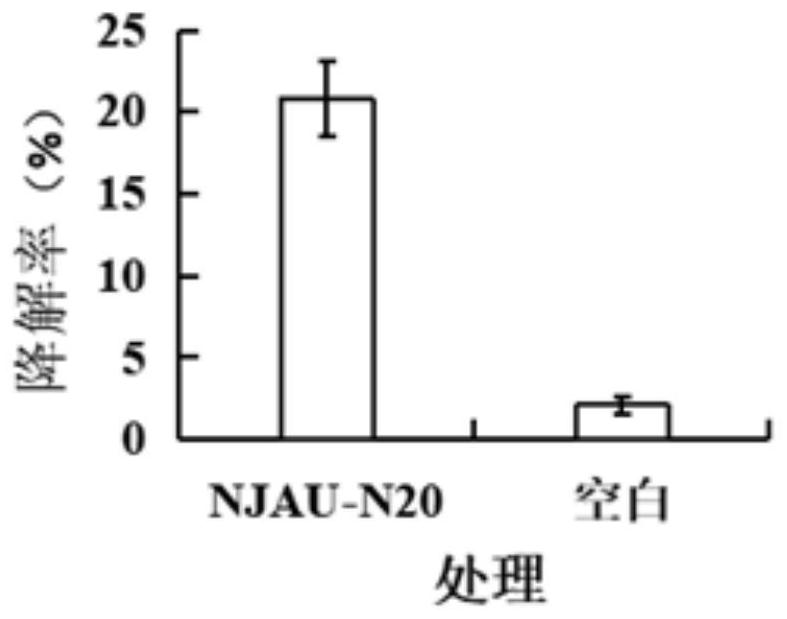High-efficiency degradation of high temperature-resistant Brevibacillus reuteri njau-n20 by wood fiber and its application
A technology of NJAU-N20 and Bacillus brevius, applied in the fields of application, bacteria, and climate change adaptation, to achieve the effects of saving production costs, shortening degradation time, and accelerating the degradation process
- Summary
- Abstract
- Description
- Claims
- Application Information
AI Technical Summary
Problems solved by technology
Method used
Image
Examples
Embodiment 1
[0026] The identification of embodiment 1 functional bacteria NJAU-N20
[0027] After the strain NJAU-N20 was cultured on LB medium with 5% salt concentration for 24 hours, it showed white dull colonies, the colonies were large, soft and viscous, irregular flakes, with scattered edges; high temperature resistant, able to grow at 50°C ;Salt tolerance, able to grow in a medium containing 15% salt; The results of the comparison analysis of the developmental tree constructed by the 16S rRNA sequence show that the strain NJAU-N20 has the highest homology with Brevibacillus reuszeri and binds to 16S rRNA Based on the comparison analysis results of the sequence-constructed developmental tree and the physiological and biochemical traits, the strain NJAU-N20 was identified as Brevibacillus reuteri. The strain is harmless to crops and non-pathogenic to humans and animals.
Embodiment 2
[0028] The lignocellulosic degrading enzyme activity of embodiment 2 functional bacteria NJAU-N20
[0029] The strain NJAU-N20 was inoculated into LB medium, and cultured at 50° C. and 170 rpm for 1 day. After the bacteria grow well, adjust the OD value with sterile water to make the concentration of the bacteria solution at 10 9 CFU / ml.
[0030] Single bacteria enzyme activity assay
[0031] Enzyme activity kits (Suzhou Keming Biotechnology Co., Ltd.) were used to determine the enzyme activities related to the degradation of lignin and cellulose for single bacteria.
[0032] (1) β-glucosidase (β-GC) activity assay
[0033] β-glucosidase decomposes p-nitrobenzene-β-D-glucopyranoside to generate p-nitrobenzene, which has a maximum absorption peak at 400nm, and calculates β-glucosidase by measuring the rate of increase in absorbance vitality.
[0034] β-GC(nmol / min / ml)=(△A+0.0027)÷0.00543×V reverse total÷V sample÷T=61.39×(△A+0.0027)
[0035] (2) Determination of exo-β-1,4-...
Embodiment 3
[0054] Example 3 Degradation of straw by bacterial strain NJAU-N20
[0055] Weigh 10g of straw powder and place it in a 250ml Erlenmeyer flask, absorb the same amount of bacterial solution into the Erlenmeyer flask, mix evenly, put it in a 50°C incubator for cultivation, and dry the sample after 15 days to weigh it to avoid inoculation. The straw at the time of planting was used as a control, and the straw degradation rate was calculated by the weight loss method. The experiment period is from March 12 to March 27, 2018.
[0056] results and analysis
[0057] Effects of high temperature strain NJAU-N20 on straw degradation as follows: figure 2 shown. The degradation rate of NJAU-N20 to straw was 20.75%, and that of the blank group was 2.08%. Compared with the treatment without bacteria, the degradation of straw increased by 18.67% with the treatment of thermomonobacteria. According to the results of indoor straw degradation, NJAU-N20 can improve the degradation of straw....
PUM
 Login to View More
Login to View More Abstract
Description
Claims
Application Information
 Login to View More
Login to View More - Generate Ideas
- Intellectual Property
- Life Sciences
- Materials
- Tech Scout
- Unparalleled Data Quality
- Higher Quality Content
- 60% Fewer Hallucinations
Browse by: Latest US Patents, China's latest patents, Technical Efficacy Thesaurus, Application Domain, Technology Topic, Popular Technical Reports.
© 2025 PatSnap. All rights reserved.Legal|Privacy policy|Modern Slavery Act Transparency Statement|Sitemap|About US| Contact US: help@patsnap.com



